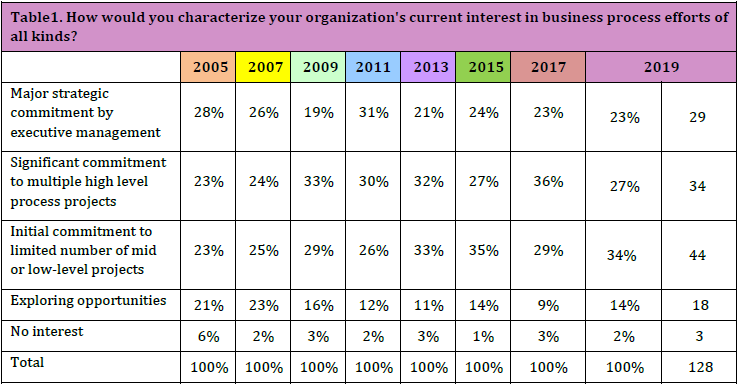The very first post that I wrote here, back in 2005, was on the BPTrends 2005 BPM Suites Report, which has evolved into their State of Business Process Management report (free, but registration required). Back in 2005, I noted that the vendors included in the report were “pay to play”, whereas by now the report is mostly BPM background/thought leadership information plus the detailed results of surveys with BPM practitioners. Although survey respondents are asked about the tools that they use, and capabilities that they require for future work, the specific vendors are not discussed in any detail. For this report, Paul Harmon of BPTrends worked together with Jorge Garcia of Technology Evaluation Centers (TEC): it appears that Harmon focused on the first section, How Organizations Understand Business Processes, while Garcia covered the second section on Business Process Software Tools. The report was sponsored by Creatio (formerly bpm’online), Signavio and Trisotech, so thanks to them for helping to make this report free to everyone (as an aside, Signavio and Trisotech are both customers of mine, but that’s not why I’m writing this post).
This quote from the executive summary really highlights why processes are such an important part of understanding how businesses are going digital:
BPTrends started tracking the process market in 2005 when BPMS tools first appeared on the scene. In the years since, enthusiasm has driven a wide variety of process initiatives. Underneath it all, however, was the interest in Internet-based tools that could model, track and control major business processes. The tools have gone through a variety of changes and are, today, powerful, widespread and widely used. The initial enthusiasm for new process work has declined a bit and current interest is perhaps better characterized by the term digital transformation, but the underlying impulse – to improve how businesses perform their work – remains.
There’s some good analysis in the report, including trends that they’ve noted from their surveys since 2005. Interestingly, the percentage of companies that see BPM efforts as a major strategic commitment by executive management has actually decreased, and is now at 23%; the biggest current characterization (34%) is companies that are working on a limited number of mid or low-level projects. That’s right, 1/3 of the respondents to the BPTrends survey – who are presumably engaged to some degree in BPM efforts – are using BPM methods/technologies only on lower-level, non-strategic projects. They spin the results in a slightly different way, pointing out that if you combine the “major strategic commitment” and “significant commitment”, it forms 50% of the respondents. Their discussion in this section explored the idea that there was a big uptake in process interest in 2007-9, but interest hasn’t really grown since then: in many organizations, a senior manager brings in process management methodologies or tools as a “pet project”, then after they move on, no one takes up the reins to continue the process improvement efforts.

Another interesting result is the major business drivers for business process change (each organization could choose multiple): reducing costs/improving productivity has steadily risen to the current high of 69%, although product innovation and customer satisfaction are also a top choice for more than 1/3 of organizations. This really highlights what I see in practice: productivity/cost are table stakes in any process improvement, and although might not be the front-of-mind reason for many executives, are expected outcomes.
The second section on BPM tools has quite a bit of information on how the respondents’ companies are using process modeling and analysis tools, but much less on process automation.
I’ve included a couple of their results here as a teaser, but I highly recommend that you head over to BPTrends and grab a (free) copy of the full report.
